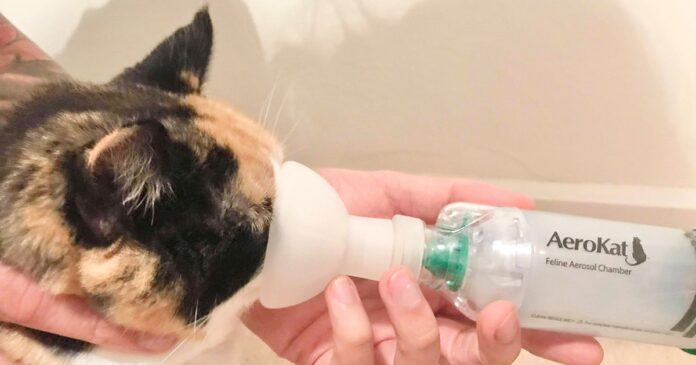Last Updated on August 19, 2023 by Fumipets
Symptoms of Cat Asthma and How to Treat It
The article “Symptoms of Cat Asthma and How to Treat It” offers insights into recognizing the signs of feline asthma and provides guidance on managing and treating this respiratory condition.
It discusses the common symptoms that cat owners should be aware of, the potential triggers, and the various treatment options available.
Symptoms of Cat Asthma
Although cats are typically thought of as independent, low-maintenance pets, they are just as susceptible to developing a chronic illness as any mammal. In actuality, cats do have certain ailments in common with people, such as asthma.
Although there is still much to learn about cat asthma, according to Stacy Choczynski Johnson, DVM, a veterinarian in Seattle, Washington, and a veterinary expert for Pumpkin Pet Insurance, they think allergens are probably what causes the disease in cats in a similar way to how it is caused in people.
The good news is that with the correct care, your feline buddy need not suffer unnecessarily from cat asthma.
Can Cats Have Asthma?
In fact, according to a study, feline asthma affects up to 5% of cats. According to Johnson, cats and people both have many of the same illness processes since they are both animals. “Humans get allergy-induced asthma,” she says. And according to our theory, cats too experience an allergic reaction caused by inhaled allergens that trigger an immunological reaction.
Depending on your location, any of the following allergens that harm cats and cause asthma might exist:
- Dust and dust mites
- Pollen
- Mold
- Insects
- Dander of other animals
- Cigarette smoke
- Room fresheners
- Smoke from fireplaces and candles
- Dust from clay litter
- Household cleaners
The reaction causes edema, inflammation, and mucus formation in the airways. As a result, the muscles there begin to spasm, which narrows the airways. Johnson continues, “What happens is a cat will breathe in.” “Subsequently, the air becomes imprisoned in those lower airways, preventing them from exhaling. When they try, they wheeze.
Cat Asthma Symptoms
According to Johnson, a cat with asthma may exhibit any of the following symptoms:
- Wheezing
- Difficulty breathing
- Rapid breathing
- A chronic cough
- Labored breathing in which they push their bellies out
- Open mouth breathing with panting
- Vomiting
The structure of a cat’s airways may really deteriorate with time. According to Johnson, this process of redesigning the airways is known as chronic coughing. Pets may also experience weight loss or changes to their coat, just as people do with any chronic illness.
Johnson says it’s important to contact your veterinarian or phone your neighborhood animal hospital to let them know you’re coming for an emergency visit if your cat displays any of these symptoms suddenly or consistently.
In order to pinpoint the exact cause of the cat’s asthma, veterinarians will do intradermal skin testing or blood tests to determine what the cat is allergic to.

Cat Asthma Treatment and Home Remedies to Make Your Kitty Feel Better
If you bring your cat to the veterinary hospital in an emergency because they are having trouble breathing, the doctor will first sedate them and give them oxygen. “It can be a kennel with oxygen supplementation or flow by oxygen,” says Johnson.
The cat will be given a bronchodilator medication—albuterol sulfate, also known as salbutamol (brand names: Proventil and Ventolin)—to treat bronchoconstriction, or constriction of the smooth muscles of the bronchus, brought on by an asthma attack, if medical professionals determine (typically by X-ray) that asthma is the cause. Johnson claims that this is not the primary cause of asthma. It’s just the first step.
“From there, we need to get rid of the inflammation, so we use steroids like prednisone,” she adds. The steroid is often available as a tablet or an inhaler, such as the AeroKat, which has a spacer designed specifically for cats that fits over their lips.
The frequency of your cat’s steroidal therapy treatments will depend on your cat’s asthma and the advice of your veterinarian.
Additionally, your veterinarian may advise allergy shots or sublingual therapy, in which allergens are formulated into a solution that is applied beneath the tongue. Johnson notes that it is “given at micro doses and gradually increased over time.”
Johnson suggests adopting the following lifestyle modifications in addition to the conventional steroid treatment:
Improve your cat’s health by getting rid of any allergies that seem to be causing the illness.
Change the air filter in your home. You may place it close to your cat’s sleeping area.
Regularly wash and dry their bedding on a hot cycle to reduce dust mites.
Avoid smoking or vaping inside.
Give your cat a salmon oil supplement if you want to reduce the inflammation brought on by their asthma since omega-3 fatty acids have been proved to do so.
What to Do If Your Cat Has an Asthma Attack
Your cat will stoop down toward the ground and stick out its head and neck when it coughs or wheezes during an asthma episode. “You should go to the vet if you notice open mouth breathing, the abdominal press, or any increase in respiratory rate,” advises Johnson.
Keep your cat as calm as you can, then put them in a container and drive off. If it’s hot outside, Johnson advises turning on the air conditioner and calling your emergency department to let them know you’re coming. “And I’m hoping they’ll prepare an oxygen cage for you. Additionally, you’ll have immediate access to treatment.
Johnson underlines the need of speaking with your primary care veterinarian or the expert managing the case if you’re dealing with cat asthma in order to acquire detailed advice about your pet. Every pet parent is aware that each cat is an individual and needs specific care.

Questions & Answers:
What are the typical symptoms of cat asthma?
Cat asthma symptoms include wheezing, coughing, labored breathing, and rapid breathing. Cats may also exhibit lethargy, loss of appetite, and open-mouth breathing during severe episodes.
What triggers feline asthma attacks?
Common triggers for cat asthma include allergens such as pollen, dust mites, and mold spores. Smoke, strong odors, and stress can also contribute to asthma flare-ups.
How is feline asthma diagnosed?
A veterinarian may diagnose feline asthma through physical examination, chest X-rays, and possibly bronchoscopy. It’s crucial to rule out other respiratory conditions that may mimic asthma symptoms.
What are the treatment options for cat asthma?
Treatment can involve both short-term management of acute attacks and long-term control of symptoms. Medications like bronchodilators and corticosteroids may be prescribed. Inhalers, often used with a spacer device, can also be effective.
Are there lifestyle adjustments to help manage cat asthma?
Creating an asthma-friendly environment involves minimizing allergens, using air purifiers, and keeping the home clean and well-ventilated. Reducing stress and providing a calm space for the cat can also contribute to better asthma management.
The article “Symptoms of Cat Asthma and How to Treat It” serves as a valuable resource for cat owners, providing information on identifying asthma symptoms, understanding potential triggers, and implementing effective treatment strategies to ensure the well-being of their feline companions.


















